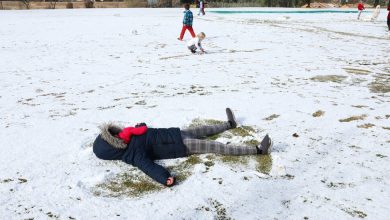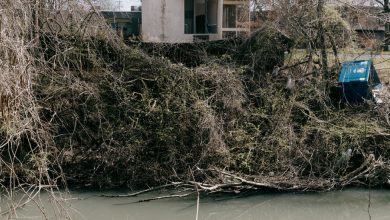Glacier Tragedy Shows Reach of Europe’s New Heat

CANAZEI, Italy — Days before a glacier in the Italian Dolomites broke off with the force of a collapsing skyscraper, crushing at least nine hikers under an avalanche of ice, snow and rock, Carlo Budel heard water running under the ice.
“I heard what sounded like a river’s torrent,” said Mr. Budel, who lives in an isolated refuge next to the glacier on the 11,000-foot Marmolada mountain. At the mountain’s base, he watched a yellow helicopter fly overhead searching for signs of life, or remains.
Mr. Budel recalled that when he first scaled the glacier at the end of summer, not even a decade ago, he hardly needed ropes there was so much snow.
“The difference between now and then is scary,” he said. “At this point we are on another path.”
It is an increasingly common path for a world confronting the deadly consequences of extreme weather brought on by man-made, and irreversible, climate change.
A year after Greece lost lives, livestock and entire swaths of forest to wildfires, and deadly floods swept through Germany, the calamity in these mountains this week provided the latest evidence that almost no part of the continent can escape the effects of Europe’s new, intense and often unlivable summer heat. That includes the highest peak of the Dolomites.
Italy is suffering through another prolonged and scorching heat wave, which contributed to the disaster and has brought the worst drought in 70 years along the Po River, its longest waterway, cutting off fountains and parching parts of the country.
“These kinds of events, they are getting more and more frequent, and they will be more frequent with enhanced global warming,” said Susanna Corti, the coordinator of the Global Change unit of Italy’s National Research Council.
Dr. Corti said that if temperatures keep increasing, “we won’t have glaciers anymore” on the Alps, a dramatic change over the last at least million years in Europe, with enormous and unpredictable consequences on the shape of the continent, vegetation, animal life and the water cycle.
Dr. Corti said glaciers needed to be monitored more carefully, because “the risk of this kind of event is increasing” and because things “won’t go back to the way they were.”
Prof. Massimiliano Fazzini, a climate expert with the Italian Society of Environmental Geology, said that Italy currently has about 920 glaciers, almost entirely in the Alps, though only about 70 of them were monitored annually by the Italian Glaciological Committee.
Their contribution of snow and melted ice varied considerably depending on the year, but the water from them was usually used to fill artificial lakes that provide electricity or to direct water to rivers in times of drought. In the last 20 years, Professor Fazzini said, Italy had lost 25 percent of the water from those shrinking glaciers.
On Wednesday, as the ominous whir of helicopters buzzed over the village of Canazei, with its neat cheese-and-chocolate-commercial alpine houses, the authorities set up under the mountain, known as the Queen of the Dolomites, and announced that aid workers had recovered the remains of two more people spotted by drones. That brought the death toll from Sunday’s avalanche up to nine people, four of whom have been identified as Italian, with five people still missing.
“We are doing everything possible to find these people,” said Maurizio Fugatti, the president of Trento Province.
They were victims of what Prime Minister Mario Draghi called “the deterioration of the environment and the climate situation.” Italy’s president, Sergio Mattarella, speaking in Mozambique on Tuesday, said it was a “symbol of what climate change, if not governed, is producing around the world.”
“There is no hope without everyone’s cooperation,” Mr. Mattarella said.
The Dolomites in northeastern Italy, with their jagged peaks, fresh air scented with the sawing of logs from the dense alpine forests, their hills gurgling with clear creeks, have long offered Italy and all of Europe a respite from the summer heat. But now they too are warming up, with the heat wave raising temperatures on the usually frigid mountains to around 50 degrees Fahrenheit.
That helped melt the ice on a glacier that, from 2004 to 2015, had already shrunk 30 percent in volume, according to a 2019 study by Italy’s National Research Council and international universities. The researchers predicted the disappearance of the glacier in 25 to 30 years.
Other experts have said that up to half of the glaciers in the Alps may disappear by 2050, and a report by the U.N. Intergovernmental Panel on Climate Change this year predicted irreversible loss of glaciers by the end of this century.
The consequences are dire for human life, the environment and local economies. The melting is even shifting national boundaries, which have often been drawn along glacial lines.
“Climate change,” Franco Narducci, an Italian politician, recently told Parliament, contributed to “the erosion and contraction of glaciers,” and forced the country to rethink how it drew its borders.
The most notable example has been the Rifugio Guide del Cervino, a traditional mountain lodge in the Pennine Alps on the border with Switzerland near the Matterhorn. The melting of a glacier has moved more of the refuge into Switzerland, causing a bureaucratic headache for the owner, who wants to stay in Italy, and an unexpected diplomatic headache for the two countries.
But now the pain is most acute in Canazei, the town in the Trentino area of Italy that sits in the mountain’s shadow.
On Tuesday, as reporters waited for helicopters to bring the region’s president to a news conference, Debora Campagnaro, whose sister Erica Campagnaro and brother-in-law, Davide Miotti, were still missing, took advantage of the assembled press to chastise the local authorities for not installing detection and warning devices that would have prevented people from approaching the glacier.
“My brother-in-law was an Alpine guide, extremely expert,” she said. “If he had only a sign of danger, he would not have gone with my sister. Husband and wife would not have left two children back home,” she said, her voice cracking.
Given the heat of the previous days, Ms. Campagnaro said, someone was to blame for not doing something. But as she broke from the crowd and returned to her car, she said there was anotherculprit: “The climactic things.”
In a grass field at the foot of the mountain, roped off with police tape, only a blue Dacia with plates from the Czech Republic remained. A sunshade glinted in the bright sun across its windshield and a spare gray T-shirt and pair of socks waited in the back. It belonged, Mr. Fugatti said, to one of the missing or dead on the mountain.
For now, only drones and helicopters have surveyed the site of the slide. Italy’s National Alpine and Cave Rescue Corps considers the glacier unstable, and too dangerous to explore by foot.
They also warned of the possibility of finding old ordinance. The glaciers played a role as a front in World War I between Austria-Hungary and Italy, when Austro-Hungarian soldiers bore tunnels deep into the ice. The retreating of the glaciers has sometimes exposed the remains of soldiers.
As technicians began equipping the area around the glacier with radar devices to sense disturbances, hikers in T-shirts and with water bottles sweated on the trails below the mountain.
“When the glacier melts, everyone will feel it, even down below,” said Anna Lazzari, 45, who came with her two children.
Her brother, Giampaolo Domidi, who has been hiking in the area for 40 years, said that the change of temperature since his youth was dramatic, and that he carried a fleece on his belt essentially as a memento of another time.
Mr. Domidi said he was “deeply worried” that global warming would make it impossible for his nephew and niece, who were sweating and exhausted next to him, to appreciate the natural wonders he grew up with.
And on the winding roads approaching the mountain and the lake fed by the glacier above, drivers got out of their cars to look at what the slide had wrought.
“They’ll never find anyone,” said Egidio Nicoletto, 74, shielding his eyes as he looked at the sheer cliff.
“Pieces, maybe,” said a motorcyclist, Raymond Oberhofer, 70.
Mr. Nicoletto said that he and his wife had a summer house nearby and that 30 years ago he skied on the glacier, even in the summer. “It was all snow, a completely different landscape,” he said. From their house, he said, they could see the majestic summit of the Marmolada, but every year “it was always less white.”
The problem, he noted, is everywhere, even in the province of Venice, where he lives. The rains there have slowed. “In Venice,” he said. “We don’t even know what water is anymore.”
In the days before the deadly slide, Mr. Budel posted a video on social media, where he has tens of thousands of followers. “Poor Marmolada glacier,” he wrote in the caption. “This year this glacier is going to get such a blow.”
Sitting in a wool hat thousands of feet below his refuge, he said that the lack of snow during the winter had left the glacier exposed, and that he had found it in worse condition in mid-June than he did last August.
“This tragedy makes us understand that climate change exists, but unfortunately it happened on a Sunday at 2 in the afternoon, the worst time and day possible,” he said. “Because if not, if it happened during the week and wasn’t a tragedy, we wouldn’t even be talking about it.”





